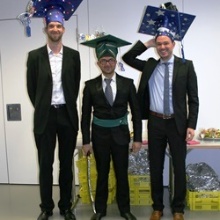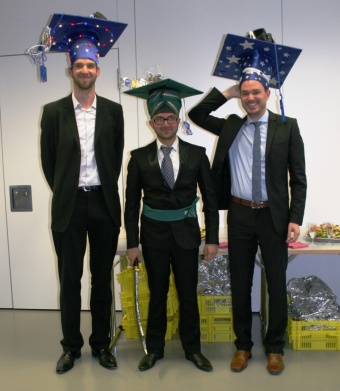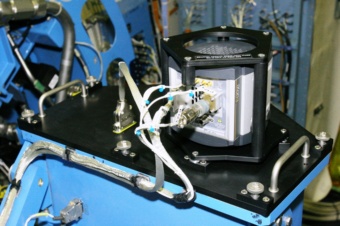-
The three freshly baked Doctors of Engineering Science: Enrico Pfüller,
Prashant Kaswekar,and Manuel Wiedemann, right after their successful
exams (Copyright: DSI).
On June 9th 2016 three PhD exams were administered at the University of Stuttgart DSI (German SOFIA Institute) to Prashant Kaswekar, Enrico Pfüller, and Manuel Wiedemann, who defended their PhD theses with excellent presentations and exam performances. The special situation here was that, in unique ways, their studies all dealt with the question of how to optimize the image stability of the SOFIA telescope. During observations the SOFIA telescope is exposed to various disturbing factors such as vibrations of the aircraft, wind loads, and temperature fluctuations. In order to satisfy the needs of the scientists using the telescope, its pointing accuracy must be 0.2 arcsec or better. That tiny angle is equal to the apparent size of a penny viewed at a distance of 16 kilometers.
-
The Fast Diagnostic Camera (alias Focal Plane Imager) attached to the
SOFIA telescope (Copyright: DSI).
The FDC also acts as the upgraded Focal Plane Imager+ (FPI+) and has been integrated into the telescope system of the observatory by Pfüller’s colleague Manuel Wiedemann (see below). In early 2016 the former FDC / FPI+ was officially added to SOFIA’s suites of scientific instruments. The FPI+ allows astronomers to conduct observations in visible light parallel to the mounted infrared instrument, and can be applied to investigations of exoplanet transits, comets or occultation of so-called Trans-Neptunian-Objects. “I would never have dreamed that the FDC would become a real scientific instrument that allows us to observe events like the Pluto occultation in June 2015”, said Enrico Pfüller as he beamed with pride.
-
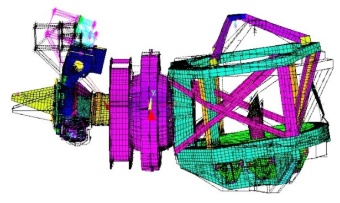
Simulations of the first bending eigen-frequency of the SOFIA telescope
system (Copyright: P. Kaswekar).
Prashant Kaswekar worked on the origins of the disturbances of the SOFIA telescope. At a speed of 800 km/h (500 mph) and an altitude of 13 km (43,000 feet), the telescope experiences significant wind loads once the cavity door is opened. Because the telescope is mounted like a dumb-bell it can easily be stimulated into oscillations with particular eigen-frequencies. To measure these states and the corresponding frequencies reliably, different sensors needed to be placed at particular locations on the telescope. In combination with kinematic models, these sensor measurements can tell which states do have an especially high impact on image movement in the focal plane. But even before the measurements can be taken the interaction between sensor data and the model – in particular the systematic errors and measurement inaccuracies – needed to be investigated and understood in detail by intense simulations. “I am just the simulation guy”, Prashant Kaswekar admits. “But seeing SOFIA in operation in Palmdale where the observatory is based significantly inspired my efforts.”
-
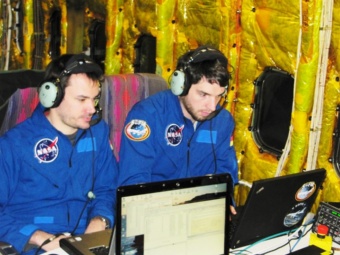
Manuel Wiedemann and Enrico Pfüller while testing the guiding cameras - during a SOFIA observing flight (copyright: DSI).
On one point, all the three examinees do agree: It is great the stress is over now!
| Contact | Dörte Mehlert; mehlert@dsi.uni-stuttgart.de |
|---|


